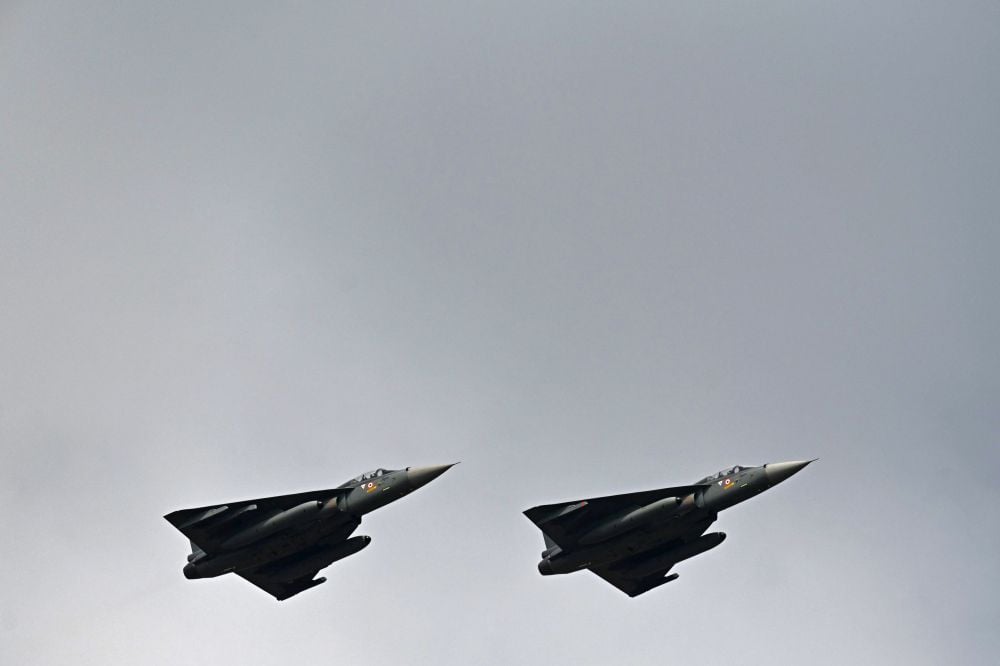HariPrasad-1
New Member
- Joined
- Jan 7, 2016
- Messages
- 9,645
- Likes
- 21,138
How Did India Manage to Build an Advanced Fighter Jet Like the Tejas?
When it comes to sensitive industries like defense, democracy and the rule of law do matter.
BY SALVATORE BABONES | FEBRUARY 24, 2021, 6:04 AM

Indian Air Force Tejas fighter jets perform at the Aero India air show at Yelahanka Air Force Station in Bangaluru, on Feb. 3. JEWEL SAMAD/AFP VIA GETTY IMAGES
India’s biennial military aircraft show, Aero India, went off without a hitch in early February in the southern Indian tech capital of Bengaluru. Despite the travails of pandemic-era traveling, the United States sent a deputy undersecretary, a Navy admiral, and three Air Force generals. It also sent a nuclear-capable B-1B bomber. But the real star of the show was what escorted the U.S. aircraft in the sky: an Indian-built Tejas fighter jet. With a name that means “radiant” in the ancient Sanskrit language, the Tejas is the first supersonic multirole fighter aircraft designed and built entirely in India.
How has a relatively poor country like India that is more famous for call centers than for precision manufacturing managed such a dramatic technological leap? In a word: cooperation. India is keen to build defense-industry partnerships with more advanced countries, and—even more importantly—advanced countries are keen to partner with India. Not only does it have one of the world’s largest military procurement budgets and a large pool of talented engineers, but India also has a strong tradition of rule of law that protects intellectual property and ensures the enforceability of contracts—in stark contrast to China, which is fast losing access to many advanced Western technologies. That makes India a better partner for international technology companies that it, for now, still depends on.
With the Tejas, India joins an elite group of countries that have demonstrated the capacity to develop and manufacture so-called fourth-generation fighters: combat aircraft characterized by electronic fly-by-wire control systems, onboard situation awareness displays, and over-the-horizon strike capabilities. The United States led the way in the late 1970s with the dual-engine F-15 and single-engine F-16, while China began producing similar fourth-generation fighters only in the early 2000s. With the F-22 and F-35, the United States has since begun to produce fifth-generation fighters—adding stealth capacity among other advances—while other countries, including India, are eager to catch up.
The Tejas is a flagship projectof the government’s Atmanirbhar Bharat or Self-Reliant India program. So far, India’s defense industry isn’t nearly as self-reliant as the government might like it to be, and the Tejas—assembled by India’s state-owned Hindustan Aeronautics in Bengaluru—is a good example: The government estimates that the fighter is just 60 percent Indian by value, though that figure is expected to rise over time. The biggest-ticket foreign components are the plane’s General Electric F404 jet engine and Israel Aerospace Industries’ radar and electronic warfare systems. Take away these key components, and all you have is an empty airframe.
For India, that’s not a problem: As a democratic country that honors contracts and respects intellectual property law, it is able to buy advanced technology that it cannot produce itself. That gives the country a major advantage over its regional rivals, China and Pakistan, which simply are not trusted by their suppliers. China’s jet fighter development programs have been repeatedly held back by Russia’s unwillingness to supply high-performance engines for fear of Chinese reverse-engineering. And key components of Pakistan’s locally manufactured JF-17 are entirely sourced from China, as is the design.

 foreignpolicy.com
foreignpolicy.com
When it comes to sensitive industries like defense, democracy and the rule of law do matter.
BY SALVATORE BABONES | FEBRUARY 24, 2021, 6:04 AM

Indian Air Force Tejas fighter jets perform at the Aero India air show at Yelahanka Air Force Station in Bangaluru, on Feb. 3. JEWEL SAMAD/AFP VIA GETTY IMAGES
India’s biennial military aircraft show, Aero India, went off without a hitch in early February in the southern Indian tech capital of Bengaluru. Despite the travails of pandemic-era traveling, the United States sent a deputy undersecretary, a Navy admiral, and three Air Force generals. It also sent a nuclear-capable B-1B bomber. But the real star of the show was what escorted the U.S. aircraft in the sky: an Indian-built Tejas fighter jet. With a name that means “radiant” in the ancient Sanskrit language, the Tejas is the first supersonic multirole fighter aircraft designed and built entirely in India.
How has a relatively poor country like India that is more famous for call centers than for precision manufacturing managed such a dramatic technological leap? In a word: cooperation. India is keen to build defense-industry partnerships with more advanced countries, and—even more importantly—advanced countries are keen to partner with India. Not only does it have one of the world’s largest military procurement budgets and a large pool of talented engineers, but India also has a strong tradition of rule of law that protects intellectual property and ensures the enforceability of contracts—in stark contrast to China, which is fast losing access to many advanced Western technologies. That makes India a better partner for international technology companies that it, for now, still depends on.
With the Tejas, India joins an elite group of countries that have demonstrated the capacity to develop and manufacture so-called fourth-generation fighters: combat aircraft characterized by electronic fly-by-wire control systems, onboard situation awareness displays, and over-the-horizon strike capabilities. The United States led the way in the late 1970s with the dual-engine F-15 and single-engine F-16, while China began producing similar fourth-generation fighters only in the early 2000s. With the F-22 and F-35, the United States has since begun to produce fifth-generation fighters—adding stealth capacity among other advances—while other countries, including India, are eager to catch up.
The Tejas is a flagship projectof the government’s Atmanirbhar Bharat or Self-Reliant India program. So far, India’s defense industry isn’t nearly as self-reliant as the government might like it to be, and the Tejas—assembled by India’s state-owned Hindustan Aeronautics in Bengaluru—is a good example: The government estimates that the fighter is just 60 percent Indian by value, though that figure is expected to rise over time. The biggest-ticket foreign components are the plane’s General Electric F404 jet engine and Israel Aerospace Industries’ radar and electronic warfare systems. Take away these key components, and all you have is an empty airframe.
For India, that’s not a problem: As a democratic country that honors contracts and respects intellectual property law, it is able to buy advanced technology that it cannot produce itself. That gives the country a major advantage over its regional rivals, China and Pakistan, which simply are not trusted by their suppliers. China’s jet fighter development programs have been repeatedly held back by Russia’s unwillingness to supply high-performance engines for fear of Chinese reverse-engineering. And key components of Pakistan’s locally manufactured JF-17 are entirely sourced from China, as is the design.

How Did India Manage to Build an Advanced Fighter Jet Like the Tejas?
When it comes to sensitive industries like defense, democracy and the rule of law do matter.
